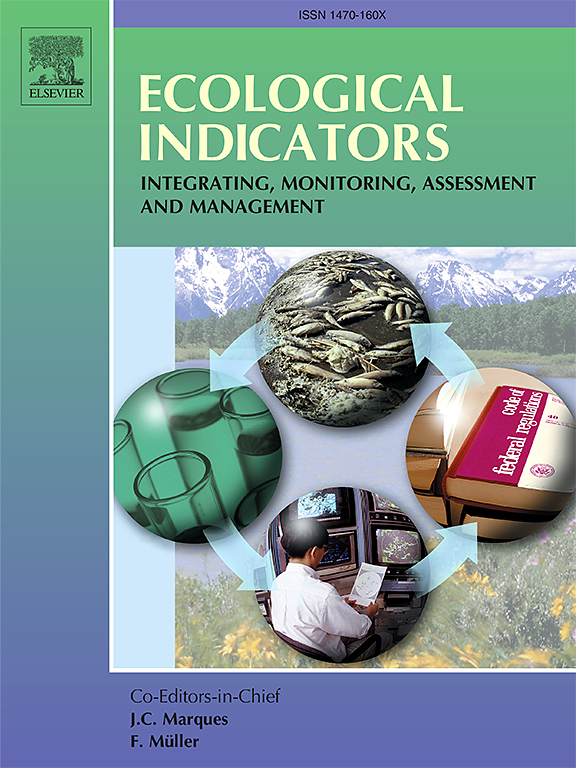三种林型林分结构特征对森林内部环境和碳汇功能的影响
IF 7
2区 环境科学与生态学
Q1 ENVIRONMENTAL SCIENCES
引用次数: 0
摘要
本研究旨在探讨无人为干扰的天然林(封山和人工林)中不同森林类型(阔叶林、针叶林和杉木林)对其综合环境功能(包括小气候调节和空气净化)和碳汇功能的影响。选取浙西地区14个样地,获得林分结构、碳汇功能(包括植被碳储量、土壤碳储量和森林植被年碳汇)和内部环境因子(包括温度、湿度、PM2.5、PM10和CO2)指标。结果表明,不同林型通过林分结构的差异影响林分内部环境的稳定性(如林分内CO2波动、大气颗粒物滞留稳定性)。树高是温度和湿度(冷却和加湿效果)的核心调节器,也参与碳储存积累。林冠闭合具有双向效应:通过增强CO2同化优化光合碳汇容量,但同时通过抑制湍流交换加剧颗粒物滞留。此外,叶面积指数(LAI)对碳汇有驱动作用(与植物年碳汇呈正相关)。这项研究的结果为确定与空气污染缓解和小气候调节相关的关键森林结构特征提供了有价值的见解。研究证实,在封山护林政策下,森林可以通过结构分化自然优化环境功能和固碳,凸显了生态保护结构与功能的协同关系。本文章由计算机程序翻译,如有差异,请以英文原文为准。
Impacts of stand structure characteristics of three forest types on the internal environment and carbon sink functions of forests
This study aims to explore how different forest types (broadleaf forest, mixed coniferous and broadleaf forest, and Chinese fir forest) in natural forests without human interference (mountain closure and forest cultivation) affect their comprehensive environmental functions (including microclimate regulation and air purification) and carbon sink functions. We selected 14 sample plots in western Zhejiang and obtained indicators of forest stand structure, carbon sink functions (including vegetation carbon stock, soil carbon stock, and annual forest vegetation carbon sink), and internal environmental factors (including temperature, humidity, PM2.5, PM10, and CO2). The results indicate that different forest types influence the stability of the internal environment (e.g., CO2 fluctuations within the stand, stability of airborne particulate matter retention) through differences in stand structure. Tree height is a core regulator of temperature and humidity (cooling and humidifying effect) and is also involved in carbon storage accumulation. Canopy closure exerts a bidirectional effect: it optimizes photosynthetic carbon sink capacity through enhanced CO2 assimilation, but simultaneously exacerbates particulate matter retention by suppressing turbulent exchange. Additionally, the leaf area index (LAI) contributes to driving carbon sinks (positively correlated with the annual carbon sink of plants). The results of this study offer valuable insights into the identification of key forest structural characteristics associated with air pollution mitigation and microclimate regulation. The study confirms that under mountain closure and forest conservation policies, forests can naturally optimize environmental functions and carbon sequestration through structural differentiation, highlighting the synergistic relationship between structure and function for ecological conservation.
求助全文
通过发布文献求助,成功后即可免费获取论文全文。
去求助
来源期刊

Ecological Indicators
环境科学-环境科学
CiteScore
11.80
自引率
8.70%
发文量
1163
审稿时长
78 days
期刊介绍:
The ultimate aim of Ecological Indicators is to integrate the monitoring and assessment of ecological and environmental indicators with management practices. The journal provides a forum for the discussion of the applied scientific development and review of traditional indicator approaches as well as for theoretical, modelling and quantitative applications such as index development. Research into the following areas will be published.
• All aspects of ecological and environmental indicators and indices.
• New indicators, and new approaches and methods for indicator development, testing and use.
• Development and modelling of indices, e.g. application of indicator suites across multiple scales and resources.
• Analysis and research of resource, system- and scale-specific indicators.
• Methods for integration of social and other valuation metrics for the production of scientifically rigorous and politically-relevant assessments using indicator-based monitoring and assessment programs.
• How research indicators can be transformed into direct application for management purposes.
• Broader assessment objectives and methods, e.g. biodiversity, biological integrity, and sustainability, through the use of indicators.
• Resource-specific indicators such as landscape, agroecosystems, forests, wetlands, etc.
 求助内容:
求助内容: 应助结果提醒方式:
应助结果提醒方式:


